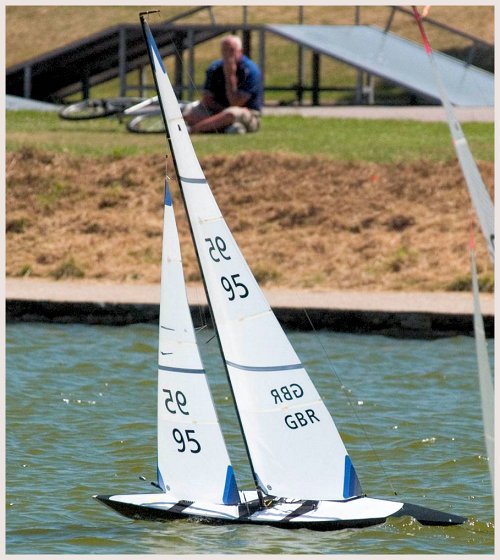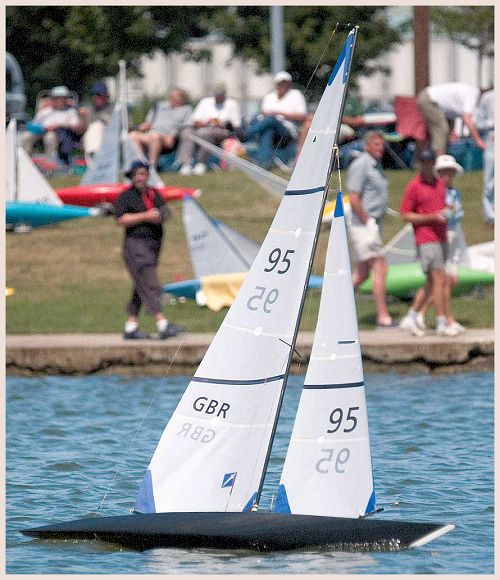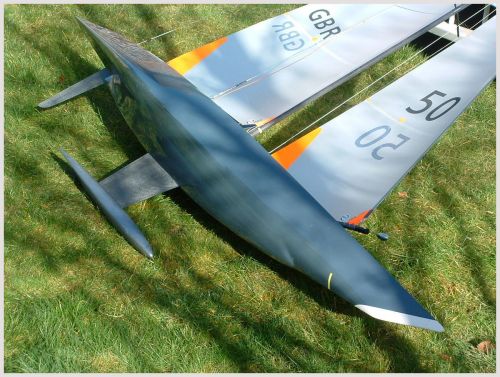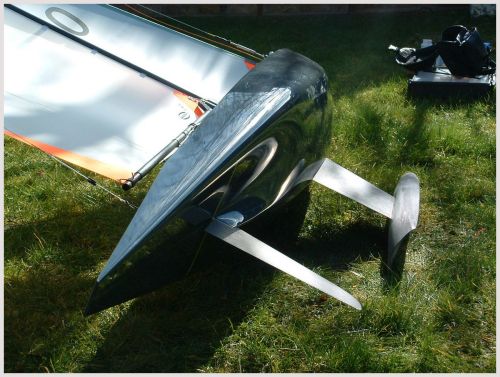A Class Gallery
|
SWORD was designed for the 2005 world championship held at Gosport. The summer winds there tend to be dominated by light airs in the morning overcome later in the day by the sea breeze and that is exactly what prevailed for the week. The boat performed well taking the top two places (2nd by Ken Binks sailing the class for the first time). Early boats were built using coloured gel coat and hand lamination into conventional moulds with ambient temperature curing. Like our Marblehead and Ten Rater the primary hull moulding of SWORD is now made in one piece using pre-preg carbon. No longer in production by SAILSetc or BOATSetc. Moulds possibly available to a builder able to use pre-preg materials - contact the SAILSetc office if interested. |
|
|
|
The hull form of SWORD allows virtually the full length to be used at normal windward sailing speeds. Although designed for best performance at Gosport for the world championship the exceptionally light construction and attention to detail gives the boat an edge across the wind speed range. The 2008 and 2009 AUS championships were won by Gary Cotterell who bought the prototype SWORD after it won the 2005 world championship. Ken Binks won the GBR Veterans' and Open championships as well as the PRACC series in 2008 with his SWORD. SWORDs have won numerous championships and other events in GBR and AUS since. |
|
|
|
This was one of the first four SWORDs and was used by Gerry Gray at the 2005 world championship. The bow chin is clearly visible in this shot. A coloured gel coat is no longer availalbe as hulls are now made using pre-preg carbon. The mast used for SWORD was originally 15.4 mm diamter carbon GROOVY. As that material became un-available we had a special tube made that tapered from 14 mm diameter round section to 14 x 5 mm elliptical section. The lower 1000 mm was made of 16.5 mm round carbon. The new mast saved weight and reduces windage at the mast head while retaining good fore and aft stiffness. Sadly the tooling has been damaged and that solution is no longer viable. Round tubes are used now. |
|
|
|
The fin and rudder have sections designed specailly for the typical operating range of Reynolds Numbers. They are made in CNC machined metal moulds that guarantee the section shape and symmetry. The ballast has a flattened section that lowers the vertical centre of gravity while increasing the effective aspect ratio of the fin. Weight reduction of the boat construction has increased the typical ballast weight from 12.5 kgs (2005) to 13.0+ kg (2009 onwards) giving a ballast ratio well in excess of 80%. The original ballast design shown in the photo has been replaced by the wider winged design that has a lower centre of gravity. |
|
|
|
The primary hull moulding has a flange about 25 mm wide running round the entire deck edge. The foredeck you can see in this shot is part of the primary hull moulding and is not an added part. The recess in it is also part of that primary moulding and not added later. It permits the attachment of headsail boom swivel to be a little lower and adds stiffness exactly where needed. Attached to the port side flange is the heavy duty block that the main sheet loop runs through, item 61-013. |
|
|
|
A ckose up of the heavy duty block. It is SAILSetc item 61-013 which is properly engineered to be strong and resistant to fouling when used with 100 kgs breaking strain line. The deck edge flange is reinforced locally with a piece of carbon plate. |
|
|
|
A close up of the foredeck. The wires are the attachment points for the headsail boom swivel used on the lower rigs. The No 1 headsail boom attaches to the steel eye (ring, 46B) which is attached to a piece of 75 kg breaking strain Dyneema line which is attached to the bottom of the hull. This long piece of line allows the headsail boom to rotate freely in light winds. The line is enclosed in a carbon tube (just visible) which is attached to the underside of the deck and the hull bottom. |
|
|
|
Access to the rc equipment is via a large hatch on the port side. The winch and servo(s) are supported in a carbon/foam/carbon tray. Fixing is provided by the quick release screws (white pillars). The pot for the receiver and battery is just visible on the left hand side of the shot. |
|
|
|
The area around the deck is shaped to gain maximum advantage within the class rules. The area in front of and each side of the mast is raised and the height of the rig is measured to the highest point. The area aft of the mast is lowered and the gooseneck/kicking strap is lowered into this depression to maximise the mainsail luff length. The mast ram is visible in the mast tube. The headsail sheet emerges from the fairlead in front of the mast. The mainsheet emerges from the fairlead to the left of the mast. |
|
|
| A view of the rc support taken from aft. The diagonals that attach the underside of the shroud attachments to the bottom of the mast tube are clearly visible. |
|
|
|
The shroud attachment system is the SAILSetc snap in/out 31S and 31-SET system. This photo is actually of the same item fitted to our Marblehead but it illustrates the attachment plate in the SWORD. The ball at the lower end of the rigging screw enters into the larger key hole near the deck edge. Once pushed into the hole it can be moved inboard until it clips into the smaller hole. Shroud tension and an integral spring in the rigging screw prevent the rigging screw from coming loose. The moulded cups (glass or carbon) and plates are available as a set of parts, item 31SET, for retro fitting to other boats. |
|
|
|
This complex shaped moulding makes the job of locating the deck edge and backstay attachment point to the bottom of the hull at the aft end of the waterline a simple task. Bonding is done with the hull in a mould so the integrity of the hull geometry is guaranteed. This part is added before the hulls leave BOATetc thus guaranteeing the integrity of the shape. The back stay attachment is visible on the hull centreline at the top of the shot. It is attached to a horizontal deck beam that is an integral part of this moulding and forms a rigid attachment. |
|
|


 Photo by
Photo by 








